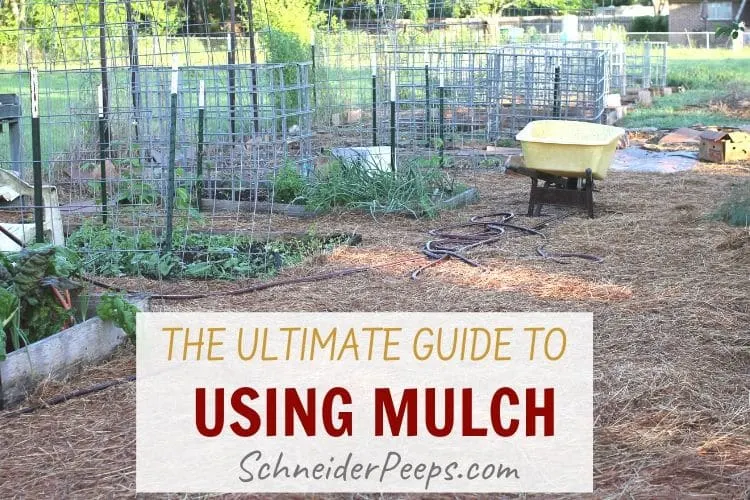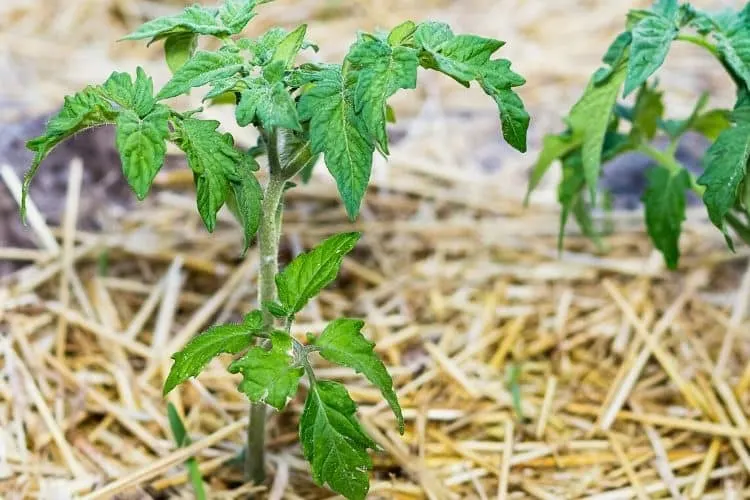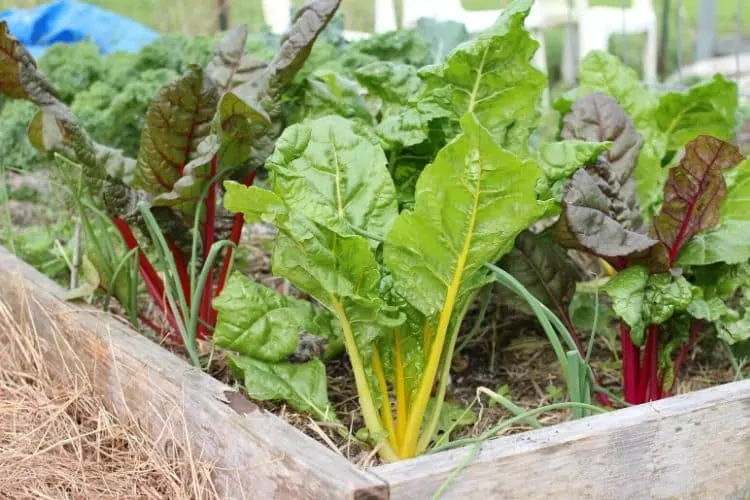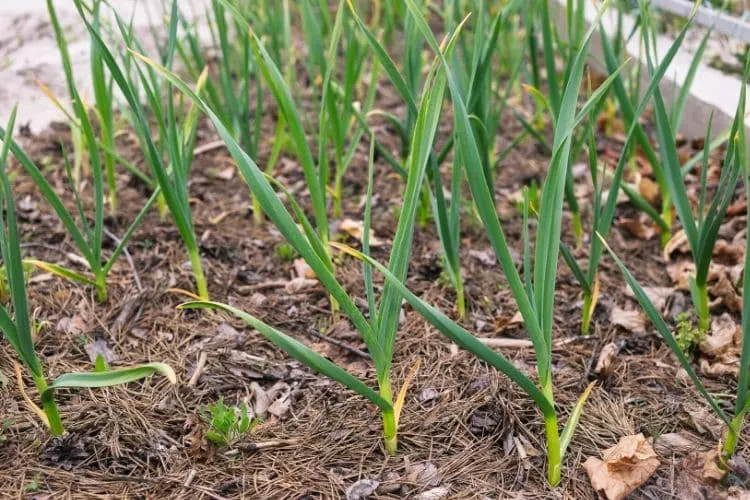Using mulch in the vegetable garden isn’t just about having a prettier garden. Mulch can help control weeds, build the soil, reduce watering, and much more. So, exactly what is mulch?

What is mulch?
There are various definitions of mulch but basically it’s anything that you put on the soil around a plant – usually 2 or more inches deep – to help control weeds and retain water. There are organic and inorganic mulches. For vegetable gardens you want to only use organic mulches.
That means the black mulches that are made out of old tires and never deteriorate are not suitable for any edible plants. Honestly, these are best for using on playgrounds and not in gardens.
Regardless of the type of organic mulch you use, I suggest putting down a layer of cardboard first. This really helps with weed control and doesn’t compact the soil.

Benefits of Mulching
I cringe just a little when I see naked garden soil. I understand why commercial growers don’t use mulch in the fields – they grow food much differently than a backyard gardener. But I’ll never understand why gardeners, even those who grow in rows and not beds, don’t use mulch because there are so many benefit to mulching.
Mulching conserves water. This is especially important when live in a place that can have 100 or more days of 100°F weather. No one wants to have water in that kind of heat any more than you have to.
Mulching helps control weeds. We control is huge in the garden and mulching helps by reducing the sunlight to gets to the dormant seeds in the soil.
Mulch breaks down and builds healthy soil. Over time, the mulch will turn into rich soil.
Mulch encourages biological activity in the soil. The dampness and rotting organic matter feeds earthworms and micro-organisms.
Mulch slow releases nutrients into the soil which means you will probably not need to fertilize your garden much, if at all.
Mulch acts a barrier that keeps soil nutrients from washing away during heavy rainstorms.
Mulch can protect plants from frost damage. Mulch is used heavily for over wintering asparagus and other edible perennials.
Mulch provides support around transplants. Most transplants have very thin stems, and mulch can help keep them upright.
Mulch can provide a home for useful insects. It can also provide a home for pests, but I’ve found that in time the good things that come from using mulch in the garden – useful insects, healthy soil and plants – keep the pest pressure under control.
Mulch is a great insulator to regulate soil temperature. I’m always amazed at how cool our soil is under the mulch during the heat of the summer. In the winter, the mulch keeps the soil warmer than it would be without mulch.
Best Mulches for Vegetable Gardens
Pretty much anything you can use for mulch on the vegetable garden, you can use for herb gardens, flower gardens, and fruit trees. Some common mulches are wood chips, straw, hay, pine nettles, and leaf litter. There are pros and cons to using each of these.

Wood Chips as Mulch
Most people use wood chips in their flowerbeds as a way to control weeds, conserve water, and honestly, just help them look nicer. You can buy wood chips fairly inexpensively at the local nursery. They come in a variety of colors which is nice for flowerbeds.
Several years ago the Back to Eden film hit the scene and caused some controversy in the gardening/homesteading community. What? Using wood chips in the vegetable garden?
Yes, wood chips can be used in the vegetable garden. However, you need to make sure you use them as a mulch – that means, they stay on top of the soil. You don’t mix them into the soil.
When you plant, brush back some of the wood chips, dig a hole, put the plant in the hole, back fill the hole with the dirt, and then smooth the wood chips back over the soil. This is the most important step when using wood chips as mulch as the wood chips will deplete the soil of nitrogen when they decompose if they’re buried.
Unless you have a wood chipper and access to a lot of tree limbs, getting enough wood chips for a large garden can be expensive. However, they break down slowly so you probably wouldn’t have to replace them all each year.
Personally, we only use wood chips in our flowerbeds because they look nicer than other mulches. We chip any tree limbs that we can and that only covers the flowerbeds. I prefer to not buy any wood chips if at all possible so we save the ones we chip for around house.

Straw as Mulch
Straw is the left over stalks from harvesting cereal grains such as oats, rye, rice, wheat, and barley. Straw is often used for bedding for livestock.
Depending on where you live, straw can be very inexpensive or it can cost quite a bit. Straw is sold in square bales and will have to be separated some before being used a mulch.
Because straw is the left over stalks of commercially grown grains, it was probably sprayed with an herbicide at some point. The good news is most almost all herbicides have a half life of under 60 days. That means that as long as the straw was cut over 60 days ago, you probably won’t have plants die because they came in contact with herbicide residue on the straw.
While I’ve used straw in our vegetable garden several times, it’s quite expensive here so I no longer use it.
If you use straw for livestock bedding you can use the used bedding in the garden but it will need to be composted or aged first. The manure and urine in the bedding is too potent to be used fresh on plants. The only exception to this is rabbit bedding – this can be used without composting.

Hay as Mulch
I’ll be the first to admit that I was super skeptical about using hay in the vegetable garden as mulch. However, when I found farmer who had old round bales for $20 a piece I decided to try them but just in the walkways.
The hay bales were 3 years old and falling apart. My husband thought I was crazy. We laid thick cardboard in the walkways and topped them with a couple of inches of old hay. It worked great and no weeds popped up.
When using hay, there is always the chance that there will be grass seed in the hay. Which can be a huge problem.
After two years of using old hay in the walkways and not seeing any seeds germinate, I decided to use in the garden beds. It’s worked really well.
Like straw, hay may have been sprayed with an herbicide, which is why old hay is a must. Also like straw, hay will need to be pulled apart before being used in the garden.

Pine Needles as Mulch
We have several large pine trees on our property and I use the pine needles to mulch various fruit trees and garden beds. Because I’m a lazy gardener I mainly just use them on the edibles that are growing near the pine trees.
I’ve heard over and over that I’m going to make our soil too acidic by using pine needles. I don’t buy it. I’ve actually tried to make soil more acidic so I could grow blueberries. And by the time the pine needles had composted down the soil had almost the exact same ph as the soil I started with.
According to the University of New Hampshire pine needles won’t significantly lower the ph level of your soil.
Pine needles are readily available anywhere there are pine trees and you can often get them for free. They also stay loose as they decompose and don’t compact like other mulches, like leaf litter and wood chips, do. This allows air to penetrate the mulch to get to the soil.
Pine needles tend to stay in place and not wash away during heavy rains. They also take quite a while to breakdown so the mulch lasts longer.

Leaf Litter as Mulch
I remember asking a friend if I could have the leaves from his live oak tree that were bagged so I could use them in the garden. He said, “Of course, but they’re too acidic to use in the garden.” I just smiled and took the leaves home.
Just like pine needles, oak leaves are acidic when they’re fresh but they neutralize as they decompose.
While most leaves can be used as mulch and composted, do not compost or use black walnut or eucalyptus leaves as mulch. These have a natural herbicide in them and you don’t want that leaching out into your compost or soil.
Every year people send tons of leaves to the landfill. These leaves could be used to build soil. Even if you don’t have a garden and have a lawn that you want to look nice, you could use a lawn mower and “mulch” or break up the leaves so that they don’t blow around and the decompose on the grass and build your soil.
Leaves are free. You could just drive around town and gather leaves from curbs. But a better idea is to talk to people who bag their leaves and ask them if they use any sprays on their trees or lawn. If they do, ask when the last time they sprayed was. Then you can decide if you want to use the leaves or not.
Also, we’ve found that sometimes people will put trash in the brown bags that are supposed to be used for lawn matter. If someone knows you’ll be coming for those bags, they’re less likely to do that.
When you mulch with leaves it’s super important to break up the leaves some. Leaves that are piled high on each other will tend to compact down and lay flat which can smother the soil. We run our leaves through a wood chipper to easily break them up. You don’t have to have a fancy one, we use our small one for leaves all the time. Or just let your kids play in the leaf pile.
We not only use leaves in as mulch but we also use them each winter to make a lot of compost that can be used all year long.

What about sheet mulching?
Sheet mulching, also called lasagna gardening, is a system of layering organic matter and letting it compost down to create loose, fertile soil that you will plant in.
This takes patience and planning but is a fantastic way to begin a garden. You’ll start by laying cardboard, then add hay, leaves, soil, etc. It’s best to use this method when starting new garden beds, but it can also be used in existing garden beds.
What is the best mulch for a garden?
Personally, I believe the best mulch for a garden is whatever material you have on your own property that you can use for mulching – leaf litter, pine needles, and wood that has been chipped are probably the most readily available.
When you use what is already on your property you know it hasn’t been sprayed with herbicides or pesticides. So, start there.
The next best mulch would be what can you get for free or very low cost from reputable sources. For me, this means 3 year old hay and leaves from friends. We will also haul cut tree branches to chip in our larger wood chipper.
Last would be purchased mulch that comes in bags at garden stores – wood chips and shredded bark. Not because it won’t work in the garden, it will work just fine. But because it’s expensive. So save the purchased wood chips for the flower beds around your house.
Since money for our gardens comes out of our grocery budget, I tent to be a very frugal gardener. These are the things I’ve decided work best for mulch in my garden. I want to encourage you to try a variety of things to see what mulch is best for your garden.
I truly believe that you can build healthy soil by composting and mulching various organic material instead of purchasing strong soil amendments. In order to use these type of amendments you will need to get your soil tested first and then apply the right amounts.
You can’t just willy nilly start adding amendments to you soil. However, you can just will nilly start mulching your garden with organic material that will break down and build the soil. So stop worrying about only using the “best” mulch in your garden, and just start mulching.

The Family Garden Plan – a short book review
I received a copy of The Family Garden Plan by Melissa K. Norris a few months ago and there are many good things going on in this book that I want to share with you.
I’ve known Melissa for years and we share similar views on growing food for our family – it’s important and it doesn’t have to be complicated.
In the book she shares her experience with growing a year’s worth of food for her family. There is plenty of information for a new gardener to get started, and plenty of information for a more experienced gardener to try new things.
The book is full of charts and workbook type pages for note taking. I’m a huge proponent of note taking for your garden in order to become a better gardener.
In the last section of the book, she has information on testing your soil and adding amendments using natural material instead of synthetic material. As someone who pretty much just mulches with whatever I have and adds homemade compost each year, I learned a lot from this section.
Planting enough to grow food for your family
Mulching the garden and building the soil is the foundation of growing food for your family. You also need to know how many plants you need to plant to grow the amount of food you want/need to grow.
You’ll want to check out this article that will walk you through figuring out how much to plant to feed your family.


Phil
Tuesday 17th of March 2020
Great post Angi! Thanks for the tip on the black walnut and eucalyptus. That's a sneaky one and if you (like I am) aren't aware of that then it's easy to accidentally add it with the compost pile or mulch.
Angi Schneider
Tuesday 17th of March 2020
You're welcome.